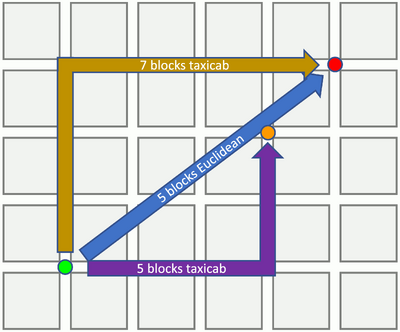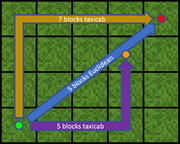
Taxicab distance is the distance a taxicab would travel on streets connecting square city blocks.
Taxicab distance, also known as rectilinear distance, city block distance, Manhattan distance, and other names, is a metric in taxicab geometry for measuring distance, as an alternative to Euclidean distance (straight-line, or "as the crow flies"). Minecraft uses taxicab distance as an efficient range measurement in several elements of the game.
Calculation
Minecraft measures the distance between two points in three-dimensional space in one of three ways, Euclidean distance, taxicab distance, or Chebyshev distance, depending on whether geometric accuracy or calculation efficiency is required.
Euclidean distance
Given two points in 3D space and , the straight-line distance (Euclidean distance) between them is:
Minecraft uses Euclidean distance calculations in cases that are relatively infrequent or when accuracy is required. This is geometrically the most accurate calculation. However, the square root calculation is processor intensive, particularly on mobile devices that may have slow processors. Too many processor-intensive operations performed during a game tick can introduce lag in the game.
Taxicab distance
The taxicab distance is a less accurate but faster calculation that can be done many times during a game tick. It eliminates the square root and squaring operations by simply calculating the absolute value (positive value) of the difference between each coordinate value:
In Minecraft, the most obvious consequence of this calculation is that a taxicab "circle" drawn with a constant taxicab radius appears as a square whose vertices are in the directions of the axes (such as torch illumination), in which the taxicab radius equals the Euclidean radius only in the four cardinal directions (north, south, east, west), and the radius is shorter in all other directions. Similarly, in three dimensions, a taxicab "sphere" appears as an octahedron.
Chebyshev distance
Chebyshev distance is rarely used in the game. It is the maximum absolute difference between two points in one of three axes:
A "circle" drawn with a Chebyshev-distance radius would appear as a square, and a "sphere" would appear as a cube.
Computationally, Chebyshev distance isn't any more efficient than taxicab distance, but it is useful for effects that need to happen in a square area or cuboid volume from a center coordinate.
Usage in Minecraft

Taxicab distance as represented by Minecraft blocks rather than city streets.
Taxicab
Minecraft makes use of taxicab distance in various situations:
- Light from light sources such as torches, campfires, lanterns, glowstone, etc. illuminate surfaces according to taxicab distance.
- As a direct result of this, torches melt snow layers within 2 blocks and ice within 3 blocks taxicab distance. Several other light-emitting blocks also melt snow in a taxicab radius; see Snow § Melting.
- Heat blocks[Minecraft Education only] melt snow layers and ice within 2 blocks taxicab distance, but do not emit light.
- Liquid (water or lava) flowing horizontally on a flat surface flows from the source in taxicab distance. For example, if flowing water is forced into a 1-block-wide stream and turns corners, it travels 7 blocks. If it is allowed to flow freely on a surface, it also travels 7 blocks taxicab distance.
- Redstone wire signals spread this way, as can be seen if a large plane of the substance is laid out.
- Levers and buttons emit a redstone signal in a 1-block planar taxicab distance around them.
- In Bedrock Edition, simulation distance is the distance from the player at which blocks get tick updates (such as lightning strikes), and beyond which mobs despawn; this also uses taxicab distance.
- In Bedrock Edition, a monster spawner spawns mobs within a 4-block taxicab horizontal range from the monster spawner.
- A sponge absorbs water up to 7 blocks away in taxicab distance (an octahedral volume centered on the sponge).
- Leaves and scaffolding determine their distance from the center via a "distance" block state determined by taxicab distance.
- Phantoms in Java Edition spawn 20–34 blocks above the player, and off to the side by a taxicab distance of up to 10 blocks.
- Using bone meal on sea pickles that are on coral blocks creates more sea pickles on nearby coral blocks out to a horizontal taxicab distance of 2.
- A block of copper is oxidized according to a taxicab distance search for unwaxed copper blocks within 4 blocks of the block being considered for oxidation.
- Shulkers can move along only one of the three grid axes at a time and on integer steps, meaning that they move according to taxicab geometry.
- Some redstone components produce block updates up to two blocks away by taxicab distance, including up and down.
The effect of simulation distance (the diamond area) on lightning strikes around a lightning rod.
Redstone lamps melting snow.
Euclidean
Situations in which Minecraft calculates Euclidean distance:
- The detection range of most mobs, if they have a line of sight to the target.
- The attenuation range of most sounds is a Euclidean sphere with a radius of 16 blocks, centered on the source of the sound.
- Mob despawning range in Java Edition.
- Disks in rivers and lakes generate as blocks within a Euclidean distance from a central block. (Small disks with a radius of up to three blocks including the center will appear identical to a taxicab diamond, however larger sizes correctly reveal a more circular morphology.)
- Effects of explosions.
- Lightning rods redirect lightning within a Euclidean spherical volume centered on the rod, having a radius of 128 blocks in Java Edition and 64 blocks in Bedrock Edition.
- The
/locatecommand. - Nether portal searches for destination portals.
- Sculk sensors and calibrated sculk sensors detect vibration emission in a spherical region.
- Splash potions affect mobs inside a 4-block radius Euclidean sphere.
- Target selectors used in commands use Euclidean distances.
- A zombie siege is started based on Euclidean distance between a player and the village center.
Chebyshev
Situations in which Minecraft calculates Chebshyev distance:
- Determining whether farmland is hydrated by a block of water in range of 4 blocks.
- A villager in Java Edition detects an iron golem within ±16 blocks on any axis, and and iron golem in Bedrock Edition spawns within ±8 blocks horizontally and ±6 blocks vertically from the village center block.
- The horizontal range of a beacon, which is 20, 30, 40 or 50 blocks depending on the size of the beacon pyramid.
- The spawning range of wardens from naturally generated sculk shriekers is ±5 blocks horizontally and ±6 blocks vertically from the shrieker.
- In Java Edition, the load level of a chunk decreases in a square pattern, creating a 23 by 23 chunk area around the world spawn known as the spawn chunks.
See also
- Taxicab geometry on Wikipedia
















